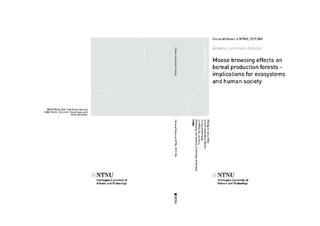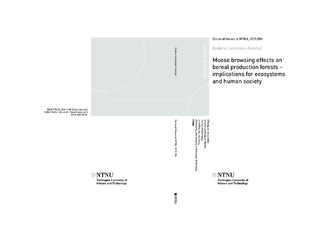| dc.contributor.advisor | Speed, James D. M | |
| dc.contributor.advisor | Austrheim, Gunnar | |
| dc.contributor.advisor | Graae, Bente | |
| dc.contributor.advisor | Strimbeck, Richard | |
| dc.contributor.author | Kolstad, Anders Lorentzen | |
| dc.date.accessioned | 2019-10-18T07:58:48Z | |
| dc.date.available | 2019-10-18T07:58:48Z | |
| dc.date.issued | 2019 | |
| dc.identifier.isbn | 978-82-326-4169-7 | |
| dc.identifier.issn | 1503-8181 | |
| dc.identifier.uri | http://hdl.handle.net/11250/2623017 | |
| dc.description.abstract | Sammendrag:
Den viktige elgen
Utmarkbeite er trolig den mest utbredte arealbruken i Norge, som i verden forøvrig. Etter at mengden beitende husdyr begynte å ned på midten av forrige århundre har ville hjortedyr tatt over deres plass i naturen. Disse ville populasjonene reguleres tett og forvaltes faktisk av landbruks- og matdepartementet. Så på mange måter kan man si at elgen er den nye kua. Hva betyr så elgen for oss? For naturen rundt oss? For samfunnet? Vi snakker om verdens største hjortedyr, en spisemaskin som kan omsette så mye som 40 kg plantemateriale om dagen. I Norge er det rekordmange elg om dagen – ofte 2 dyr per kvadratkilometer flere steder. Dette tilsier at elgen kan ha virkelig mye å si for skogen der den bor, og skal vi nå bærekraftsmålene til FN, og skal vi klare å reversere klimaendringene, ja da kan vi faktisk ikke la være å tenke på elgen.
Mitt doktorgradsarbeid har bekreftet at dagens beitetrykk fra elgen går hardt utover løvtrærne som den lever av. Men at det i hele studieområdet vårt ikke skulle finnes en eneste rogn som hadde unnsluppet elgens kjever, det var allikevel dystert nytt. I hvert fall for oss som ønsker å se løvtrær og artsmangfold i skogene. Jeg har også studert hvordan endringene forplanter seg i jordsmonnet og i undervegetasjonen. Ja elgen er viktig for hele økosystemet.
Men elgen er også en del av mangfoldet. Og den er jakt, den er kultur og den er tradisjon. Så hvordan veier vi opp alle disse positive og negative sidene ved elg? Avhandlingen min rundes av med oppstarten på noe nytt – ett nettbasert samarbeids og -læringsverktøy for å forstå elgens mange roller i naturen og i samfunnet. Gjennom tverrfaglig samarbeid og med tettere kontakt mellom forskere og samfunnet for øvrig, legger vi grunnlaget for å mer bærekraftig fremtid. | nb_NO |
| dc.description.abstract | Summary of thesis:
The important moose
Pastoralism and wild animal grazing on unfenced lands is probably the most extensive land use in Norway, as it is in the rest of the world. After the number of livestock grazers started to decline mid last century, wild species have grown to take their place. These wild ungulates are strictly regulated, under the jurisdiction of the Norwegian Ministry of Agriculture and Food. So, you could say that moose is the new cow.
We are talking about the world’s largest species of deer, an eating machine that can munch down as much as 40 kg of plant matter every day. In Norway there are record amounts of moose at the moment – often 2 animals per km2 in many places. This suggest that moose may really have a big effect on the forests where it lives and that if we are to reach the UN sustainability goals, and if we are to reverse climate change, then we cannot afford to ignore the moose any longer.
My doctoral work has confirmed that todays browsing pressure from moose is quite detrimental to the deciduous trees that it feeds on. But that we should not find a single rowan tree within our entire study area that had escaped the moose’s grinding jaws, that was rather sad news. At least for those of us that put a high value on deciduous trees and biodiversity in the forest. I have also studied how these changes subsequently influence the forest soils and understory vegetation. Yes, moose is important for the entire ecosystem.
But moose is also part of the diversity. Over 60000 Norwegians participate in the annual moose hunt, and associate moose first and foremost with social and cultural values. My thesis ends with something new – a web-based co-operation and learning tool for understanding the many roles that moose have in Norwegian nature as well as society. With interdisciplinarity and closer ties between scientists and society at large, we are laying the foundation for a more sustainable and equitable tomorrow. | nb_NO |
| dc.language.iso | eng | nb_NO |
| dc.publisher | NTNU | nb_NO |
| dc.relation.ispartofseries | Doctoral theses at NTNU;2019:286 | |
| dc.relation.haspart | Paper 1:
Kolstad, Anders Lorentzen; Austrheim, Gunnar; Solberg, Erling Johan; De Vriendt, Laurent; Speed, James David Mervyn.
Pervasive moose browsing in boreal forests alters successional trajectories by severely suppressing keystone species. Ecosphere 2018 ;Volum 9:e02458.(10) s. 1-19
This is an open access article under the terms of the Attribution 3.0 Unported (CC BY 3.0)
https://doi.org/10.1002/ecs2.2458| | |
| dc.relation.haspart | Paper 2:
Kolstad, Anders Lorentzen; Austrheim, Gunnar; Solberg, Erling Johan; Venete, Aurel M A; Woodin, Sarah J.; Speed, James David Mervyn.
Cervid Exclusion Alters Boreal Forest Properties with Little Cascading Impacts on Soils. Ecosystems 2018, Volume 21, Issue 5, pp 1027–1041
- Is not included due to copyright available at
https://doi.org/10.1007/s10021-017-0202-4
or the authors accepted manuscript in NTNU Open
http://hdl.handle.net/11250/2466283 | |
| dc.relation.haspart | Paper 3:
Kolstad, Anders Lorentzen; Austrheim, Gunnar; Graae, Bente; Solberg, Erling Johan; Strimbeck, Richard G.; Speed, James D.M.
Moose Effects on soil properties, tree canopies and understory vegetation - a path analysis | |
| dc.relation.haspart | Paper 4:
Kolstad, Anders Lorentzen; Austrheim, Gunnar; Aasetre, Jørund, Bright, Ryan M.; Magerøy, Melissa H.; Olaussen, Jon Olaf; Solberg, Erling J.; Stokland, Håkon B.; Speed, James D.M.
Promoting system thinking and collaborative learning in boreal forest management using a web - based knowledge system
- This article is awaiting publication and is not included in NTNU Open | |
| dc.title | Moose browsing effects on boreal production forests – implications for ecosystems and human society | nb_NO |
| dc.type | Doctoral thesis | nb_NO |

